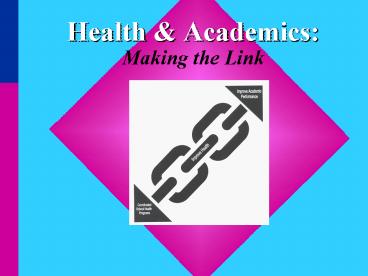Health - PowerPoint PPT Presentation
1 / 17
Title:
Health
Description:
Research & Health Behavior. Exposure to violence. has negative. psychological and. physiological ... Teenage Pregnancy and Drug Abuse. ERIC Document 316615. ... – PowerPoint PPT presentation
Number of Views:34
Avg rating:3.0/5.0
Title: Health
1
Health Academics
- Making the Link
2
Goals for Education
RAISE ACADEMIC PERFORMANCE
IMPROVE CHILDRENS WELL-BEING
and
3
Goals for Education
Improving academic performance
by increasing well-being
IMPROVE CHILDRENS WELL-BEING
RAISE ACADEMIC PERFORMANCE
4
Research Health Behavior
14.5 of Massachusetts teens smoke daily. 1997
MYRBS
Tobacco use decreases attention
span and concentration. 1998 U.S. Dept of Health
Human Services
5
Research Health Behavior
53.5 of teens drink alcohol on a monthly
basis. 30.9 of teens smoke marijuana on a
monthly basis. 1997 MYRBS
Alcohol drug use impair the brains ability
to process information, form memories, and
recall information. Jaffe, 1980.
6
Research Health Behavior
30.3 of Massachusetts teens have dieted in
the past 30 days. 1997 MYRBS
Poor nutrition decreases cognitive functioning
and performance in the areas of language,
concentration, attention. Wehler, Scott,
Anderson, 1996
7
Research Health Behavior
Exposure to violence has negative psychological
and physiological consequences that can have
detrimental effects on school
performance. Prothrow-Stith Quaday, 1995
36 of teens have been in a physical fight
within the past year. 1997 MYRBS
8
Some Other Interesting Facts
- Students with poor nutrition low levels of
physical fitness are more likely to be absent and
tardy. Murphy, 1998 - Students who are threatened with physical
violence may avoid school. Massachusetts Youth
Risk Behavior Survey, 1997 - Substance using or pregnant students are more
likely to drop out of school. Bempechat, 1989
9
How do we create an academic environment that
ischallenging and rigorouswhile nurturing the
students well-being?
10
Comprehensive School Health
Massachusetts Department of Education Health
Framework 1999
11
CSHP Practices Related to Decreases in Student
Risk Behavior
- Exposure to Health Curriculum
- Involvement of Important Adults
- Involvement of Important Peers
- Local Program Evaluation
Health Protection Fund Year V Evaluation 1999
12
An example...
- Students who have been taught about AIDS/HIV
infection in school were significantly more
likely to report ever having talked with their
parents and family about HIV/AIDS than those who
had not. (58 vs.38) - Students who have been taught about AIDS/HIV in
school are less likely than their peers to have
had sexual intercourse in their lifetime. (47
vs. 56)
1997 Massachusetts Youth Risk Behavior Survey
13
Comprehensive School Health Programs School
Performance
- Increased grade point average (Hawkins et al,
1999) - Increased course grades in math English
(Murphy et al, 1996) - Increased achievement scores in reading
(Lindmark, 1996) - Increased standardized test
- performance (Simun, 1996)
14
Comprehensive School Health Programs School
Performance
- Increased cognitive development awareness (U.S.
Senate, 1993) - Increased attendance (U.S. Senate, 1993)
- Increased graduation rates (Pitway Charitable
Foundation, 1992) - Increased goal setting, problem identification,
decision making, communication (Mohai, 1991)
15
Health Academics Making the Link
16
- Comprehensive School Health Programs offer the
opportunity for us to provide the services and
knowledge necessary to enable children to be
productive learners and to develop the skills to
make health decisions for the rest of their
lives.
National School Boards Association
17
References
- Anderson, G. (1993). When Chemicals Come to
School The core team model of student assistance
programs. Greenfield, WI. - Bempchat, J., et al. (1989). Teenage Pregnancy
and Drug Abuse. ERIC Document 316615. - Hawkins, J.D., Vatalano, R.F., Kosterman, R.,
Abbott, R. Hill, K.G. (1999). Preventing
adolescent health-risk behaviors by strengthening
protection during childhood. Archives of
Pediatric Adolescent Medicine, 153, 226-234. - Jaffe, J.H. (1980). Drug addiction and drug
abuse. In A.G. Goodman, L.S. Gilman A. Gilman
(Eds.) The Pharmacological Basis of Therapeutics.
New York, NY. Macmillan Publishing Co. - Lindmark, T., Marshall, J. Riley, S. Strey, E.
(1996). Improving Behavior and Academic Success
Through a Caring Classromm. Masters Thesis,
Saint Xavier University. ED 399 493. - Massachusetts Department of Education. (1998).
Year V Evaluation of the Health Protection Fund.
Malden, MA Author - Massachusetts Department of Education. (1999).
Massachusetts Comprehensive Health Curriculum
Framework. Malden, MA Author - Massachusetts Department of Education. (1998).
1997 Massachusetts Youth Risk Behavior Survey
Results. Malden, MA Author - Prothrow-Stith, D., Quaday, S. (1995). Hidden
Casualties the Relationship between Violence and
Learning. Washington, D.C. National Health and
Education Consortium. - Mohai, C. (1991). Peer Leaders in Drug Abuse
Prevention. ERIC Document 341892. - Murphy, J., Pagano, M.E., Nachmani, J., Sperling,
P., Kane, S., Kleinman, R.E. (1998). The
relationship of school breakfast to psychosocial
and academic functioning. Archives of Pediatric
Adolescent Medicine, 152, 899-907. - Murphy, J., Wehler, C.A., Pagano, M.E., Little,
M., Kleinman, R.E., Jellinek. M.S., (1998).
Relationship between hunger and psychosocial
functioning in low-income American children.
Journal of American Academy of Child and
Adolescent Psychiatry, 37, 163-170. - Pitway Charitable Foundation. (1992). Success for
Every Teen Programs that Help Adolescents Avoid
Pregnancy, Gang, Drug Abuse, and School Drop-Out.
ERIC Document 352596. - Rothman, M.L. Ehreth, J.L. Palmer, C.S. Collins,
J. Reblando, J.A. Luce, B.R. (1993). The
potential benefits and costs of a comprehensive
school health education program. Paper presented
at the annual meeting of the American Public
Health Association, San Francisco, CA. - Simun, P.B., Slovacek, S.P., Batie, M., Simun, M.
(1996). Project Support Evaluation. Los Angeles
Unified School District, report 3-Final
Evaluation. ED 398 291. - United States Department of Health and Human
Services. (1998). Health Consequences of Smoking
Addiction. A report to the surgeon general.
Washington, DC Author. - Report to the Chariman, Committee on Labor and
Human Resources, U.S. Senate. (1993).
School-linked human services A comprehensive
strategy for aiding students at risk of school
failure. ERIC Document 372818. - Wehler, C., Scott, R., Anderson, J. (1996). The
Community Childhood Hunger Identification
Project. Washington, D.C. Food Research
Action Center.































